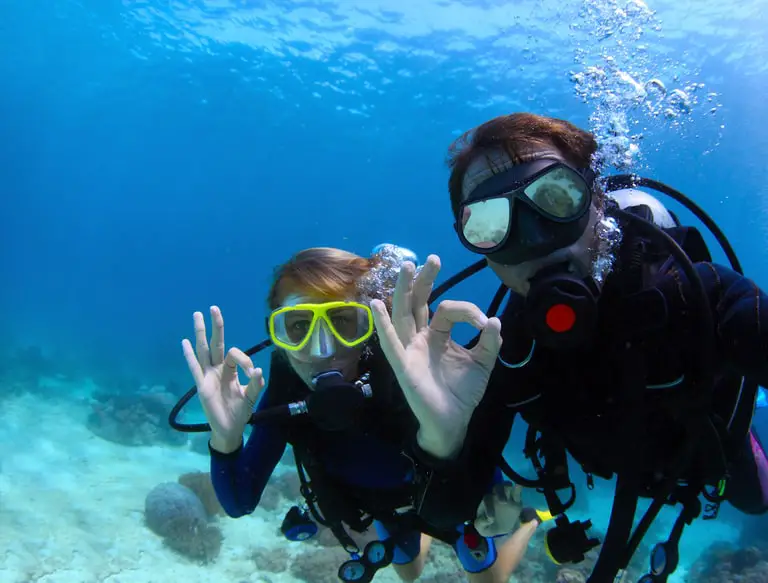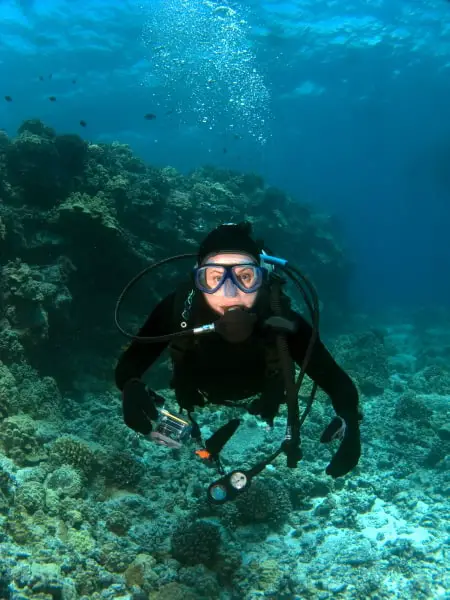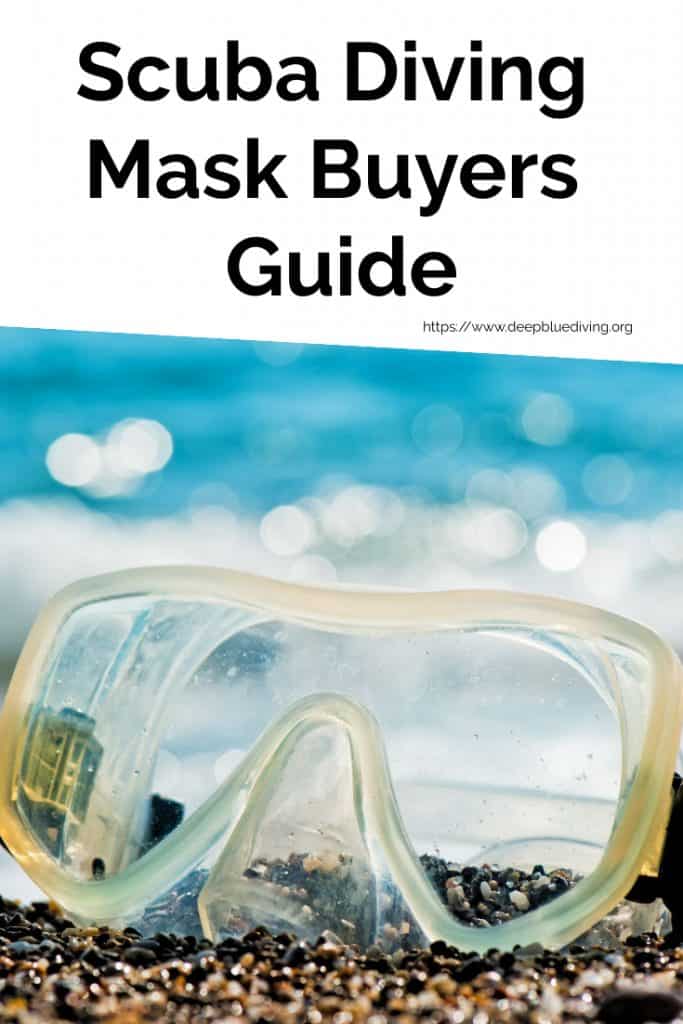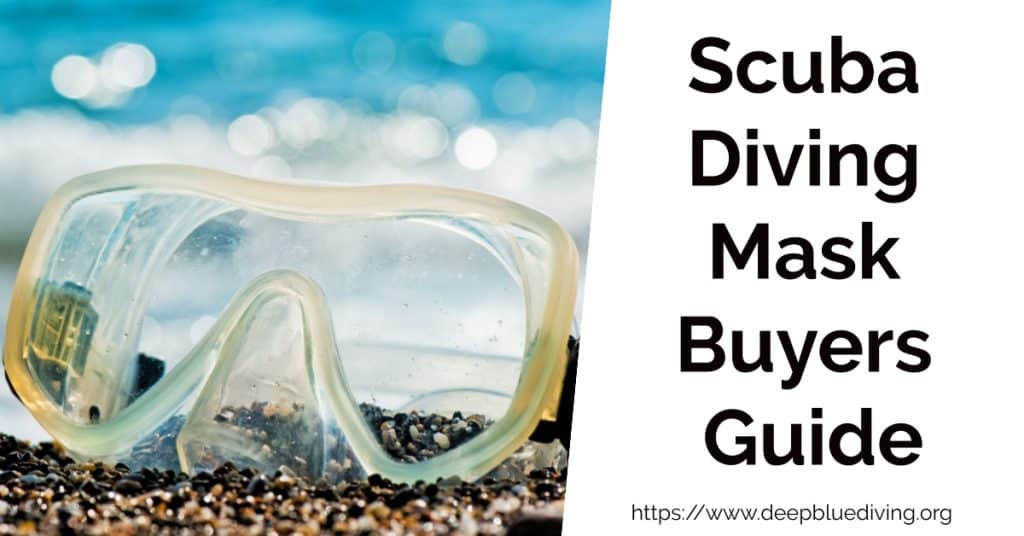Scuba Diving Mask Buyers Guide – What you need to consider!
There are a few things you need to consider when you’re out buying a scuba mask. The most important is that you get a dive mask in the color you like best. Just kidding…
Let’s have a look at what you need to consider when you’re looking for a new mask in our scuba diving mask buying guide!
Why do you need a mask in the first place?
There are some factors to consider and several components that make up a scuba diving mask that you should be aware of. The first question you might wonder about is why you even need a dive mask. Couldn’t you open your eyes underwater?
The simple answer is that the human eye is incapable to focus underwater. Therefore, a mask keeps the water away from the eye and allows you to see clearly and focus while in water.
To keep water out and the air inside, the silicone skirt of the mask has to sit tight against the skin on your face. This seal will prevent water from flowing into the mask and as such allowing you to see while you’re underwater.
Most high-quality masks have specifically designed silicone skirts that tightly seal to your face. The materials used are made from hypoallergenic silicone. If you have an allergy to latex, then know that you are safe with such masks.
If you are looking to use these masks for snorkeling then it might be worth having a look at specific snorkel masks that let you breathe through your mouth or nose. These also don’t have a mouthpiece to bite down on. Have a look at the highest-rated full-face snorkel masks here!
Why do you need a nose pocket?
While you dive into the depth of the water, you will need to equalize. The most common technique to do that is to blow into your nose while you hold it. A scuba diving mask, therefore, has a nose pocket that allows you to access your nose while you descent or ascent – did old school diving masks have a nose pocket?
The nose pocket of the dive goggles covers your nose and prevents water from getting into it while you dive. It also allows you to equalize the air trapped inside the mask.
This does tremendously improve the comfort of wearing the mask but is also a safety issue. Not being able to equalize the air inside the mask while you descent can prevent the mask from suctioning itself tightly and painfully to your face.
Another reason is that you can blow into the mask through your nose. Any water that found a way inside the mask can that way be purged.
Swim goggles leave your nose exposed and therefore are not a good choice for scuba diving. They are designed for lap swimming and not for scuba diving or snorkeling.
Why would you need lenses made from tempered glass?
Another issue with goggles as well as with cheap dive masks is that the lens is not made from tempered glass. They are using plastic lenses which will most likely fog when you dive. In the worst case, they might even break with the pressure around you.
The last thing you want is a lens made from regular glass or plastic that breaks in the middle of a dive. The sharp fragments could produce some severe damage to your eyes!
Tempered glass is safe and won’t easily break. Even if a tempered glass lens would break, it usually won’t fall apart so there wouldn’t be any sharp fragments to cut yourself with.
Another advantage of using tempered glass in scuba masks is that it is scratch-resistant. This prolongs the lifetime of the scuba diving mask as it otherwise could easily scratch while you transport it with other scuba diving or snorkeling gear.
Can you buy scuba diving goggles online?
You also might be wondering whether it’s a good idea to buy a dive mask online. The truth is that most masks will fit most divers. The skirts are soft and flexible and adjust to the shape and contours of the diver’s face.
That might not be true for cheap scuba masks though. There you might end up with low-quality material components that will not easily mold to your face!
Does it have to be a Dive Mask?
When you start looking around, you’ll find scuba masks for scuba diving, spearfishing, freediving, and snorkeling, to name a few. To some degree, these masks are similar or even the same.
There are some subtle differences though. For example, a typical snorkel mask might use lesser-quality materials. You won’t dive down, and the pressure won’t build up around the mask, so there’s no need to go for more expensive top-notch components.
You most likely won’t have an issue using a scuba mask for snorkeling though. Or for most activities underwater. A good scuba diving mask will have a low profile and a low-volume design to trap only the minimal amount of air. The reason for that is that a lot of air caught in the mask will impact your buoyancy and make it harder to dive down.
A diving mask for freediving will be designed as a low-volume mask. It traps a minimal amount of air inside and the lenses are very close to your eyes.
Single, Dual or Multiple Lenses
Historically dive masks had either one or two lenses. A mask with a dual-lens design results in a separator along the nose. Single-lens masks don’t have that separator, so you overall have a better view.
If you need your lenses set up with prescription glasses, then you can’t have single lens masks! Take that into consideration when shopping for a mask and wearing glasses where you require corrective lenses!
Masks with multiple lenses usually have a single lens or two lenses in the front and then two lenses on the side. This gives you a better side view. Overall, this might feel more natural for some people.
The Angle of the Lens
Sometimes you can see old dive masks that pretty much run parallel to the face. Modern masks often (usually) have an angle where they slope towards the cheekbones at the bottom. This reduces the internal volume of the mask and more importantly makes it easier to look down.
Field of View
The most important feature of a mask is that it lets you see underwater. A good scuba diving mask will not only allow you to see straight out of the mask but give you some area up and down and left and right where you can look at your environment. The larger the field of view, the closer you get to having the best scuba diving experience possible.
This is the field of vision. It’s quite essential that you have a good look downwards and as wide a field of vision as possible. Why might you ask? Well, that’s where all your gear is.
All your gear and gauges are towards the bottom of your body. Having a clear view of all of those devices can make it a lot more comfortable to dive as it’s easier to access all those parts.
Clear or Reflective Lenses?
This is pretty easy. When you dive, it’s dark. There’s no sunlight when you go down and as such, there’s no good reason to have reflective lenses to reduce glare.
The primary concern of reflective lenses is safety-related. When you have an issue during your descent or ascent and others need to help you, then they can’t see your eyes if you have reflective lenses.

Comparing Scuba Masks vs Goggles – What are the Differences?
Your eyes are one of the first things your buddy or a rescuer will look for to see whether you’re in trouble, unconscious, etc. Reflective lenses prevent anyone from being able to see your eyes which makes it a huge safety concern. In short, stick with clear lenses and you end up safer!
Frame or Frameless Design
The majority of dive masks have a frame. Pretty much all components of the mask are attached to the frame. These are the lens/lenses, silicone skirt, and the straps and buckles. The frame holds it all together and allows you to take it apart for cleaning and maintenance.
The downside of a frame can in some cases be that it is too bulky and gets in the way or disturbs your field of view. Some manufacturers try to overcome that by using clear silicone for the frame which allows you to be somewhat able to look through it.
There are a few masks out there that have frames that allow you to disassemble the mask. This provides you a great way to clean all components separately. It’s also an advantage when a single part breaks and you can replace it instead of having to buy a new mask. In some cases, you also can simply replace the existing lenses with prescription lenses.
Frameless design masks have the silicone skirt molded around the other parts of the mask. They are not assembled but become one piece.
The result is that they typically are smaller and slimmer. Some of them are small enough to fit into a pocket. They are also usually much lighter compared to masks with a frame. Lastly, they often also provide a wide field of view for the diver.
The downside is that you can’t take them apart for cleaning or repair. You usually also cannot install prescription lenses in a frameless scuba dive mask.
Adjustment Possibilities
It is essential to be able to adjust the scuba diving mask, so it fits your face and head. If every head were the same shape, then it would be simple to build a mask that fits perfectly for everybody. As this is not the case, the masks need straps and buckles that allow adjusting the fit.
Most newer and modern masks have the attachment area for the buckles as part of the skirt. This reduces the pull on the frame and allows the silicone skirt to create a tighter seal.
There are undoubtedly different buckles and strap systems. Some are easy to pull and adjust and others not so much. Typically, buckles that are integrated into the skirt are overall more straightforward to handle.
Mask Skirt
The function of the mask skirt is to provide a tight seal between the mask and your face. This is necessary to ensure that the water stays out of the mask while the air stays inside. If the seal between the silicone skirt and the skin is not tight, then the mask will leak.
Many of the best dive masks come with dual skirts to provide a better and tighter seal. Such a dual mask skirt usually creates a more reliable and also more comfortable connection to your skin.
Other alternatives are specifically formed silicone skirts that create a tight fit. Modern mask skirts are made from high-quality silicone as it is very flexible and durable.
Every scuba diving mask manufacturer varies the silicone they use. Some use softer and other stiffer versions. Depending on the brand and quality the thickness of the silicone is also different. The best scuba masks from the top-rated brands will use a mix of soft and sturdier material for the skirt.
Skirts on many scuba diving masks come in different colors. Traditionally, the skirts were and often still are black. For some people, this can be a problem if they are claustrophobic. Black or otherwise dark skirts have an advantage as they block glare and reflecting lights.
Scuba diving masks with clear skirts let more light into the mask. This makes it feel airier for people that are claustrophobic. That additional light makes them a great choice in not-so-clear waters. On the other hand, they do let a lot of reflected light into the mask if you dive in clear waters and bright light which can quickly strain your eyes and merely be annoying.
Mask Volume
The internal volume referred to is the amount of air being trapped within the mask. The less air space inside, the better for scuba diving.
A low-volume design mask has many advantages. First, they require less breath to clear if water gets into the scuba mask. The low profile makes it easy to clear the scuba mask underwater as there’s less air space inside the mask.
The second advantage of dive goggles with lower internal volume is that they produce less drag when scuba diving. Also, as there’s less air they also have less of a buoyancy impact compared to a pair of scuba goggles with a lot of air.
The lenses in a low-volume mask sit closer to your eyes. This usually creates a wide field of view that allows you to see more of the underwater world you’re exploring.
Special freediving masks are designed to have extremely low volume. This reduces the amount of air even more and makes it easier to dive down. However, the closeness of the lenses and the silicone skirt can make it a real problem for people that are claustrophobic.
Overall Fit
Finding a scuba diving mask that matches your head and face is crucial. The mask has to fit comfortably and has to have the right size for your face. Most dive masks come in different sizes, and if your mask is too big, then it won’t be able to create a tight fit.
A well-fitting mask will stay on your face if you put it on without the silicone or neoprene straps and then inhale through your nose to create a vacuum. If the scuba diving mask is the right size for you, then it will stay on. If it’s too large, then it will fall off as there’s no tight seal. That is hands down the best method to figure out whether a mask fits or not.
How to find the Best Full Face Dive Masks with Communications

Purge Valves
Very few divers have continuous issues finding a mask that fits perfectly. However, most divers at some point will have a scuba mask that leaks. Having a scuba mask with a purge valve can be a good alternative for them.
It can also be a good idea to get such a mask if you cannot stand the thought of any water accidentally building up inside. The valve is usually located at the bottom of the nose pocket.
The valve is designed to drain any water building up inside the scuba mask. Most masks with such a purge valve will allow getting rid of water with just a gentle blow through your nose.
You might think that this could be the solution to the problem of all ill-fitting masks. It’s unfortunately not. The disadvantage is that you have another component on your scuba mask that can malfunction.
Any valve can quickly turn into an opening if a tiny piece of dirt gets lodged in it. If that happens, you end up with a leaky mask, and if you can’t clear the debris from the valve you might have to purchase a new one.
You can clear a scuba mask without a purge valve quite easily. Hold the top of the mask against your forehead, tilt your head back a little and then strongly blow through your nose until the water is out of your mask.
Preparing a new Mask, Maintenance Tips, and Accessories
Getting a new scuba mask is exciting. Before the first use, you should prepare the goggles to get the optimum performance from them.
Scrub it out with toothpaste, soft scrub, or whatever method the manufacturer recommends. This cleans off any residue from the manufacturing process which can fog up otherwise.
Use defogger on the lens(es) before each dive. This prevents or at least dramatically reduces any fog build-up while you’re underwater.
After each dive, you have to rinse your mask with fresh water. This will remove any residue building up from your last dive.
You also want to keep the scuba mask out of the sun. The UV rays of the sun can break down the silicone and shorten the lifespan.
When storing the scuba mask be careful to keep it in a well-ventilated space. Only save it when completely dry.
You also want to make sure that you keep it away from bugs. Some do eat silicone which, as you can imagine, is not a good thing!
When you get a new mask, specifically an expensive one, you might want to consider keeping a few accessories around. It’s always a good idea to get a case that is made for your mask. It will make it easier to travel and store.
Strap covers can also be a great idea. They are usually made from neoprene and will slide over the silicone straps. The advantages are that you can move them around easier even if you wear gloves. They also will no longer tangle and yank your hair making it much easier to put the mask on or off.
When you’re going on a trip with your mask, then you should consider bringing a set of extra straps with you. In case that one of your straps breaks you have a replacement with you instead of cutting your dive short.
Final Thoughts
There you have it. If you take all of these considerations and evaluate a dive mask against them then you’ll find a great pair of dive goggles for yourself that allow you to enjoy the underwater world in all its beauty.
You also can shorten the search and have a look at our evaluations of the best scuba diving masks at https://www.deepbluediving.org/best-scuba-diving-mask-reviews/.


